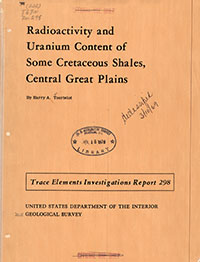Radioactivity and uranium content of some Cretaceous shales, central Great Plains
Links
- Document: Report
- Download citation as: RIS | Dublin Core
Abstract
The Sharon Springs member of the Pierre shale of Cretaceous age, a hard black organic-rich shale similar to the Chattanooga shale, is radioactive throughout central and western South Dakota, most of Nebraska, northern Kansas, and northeastern Colorado. In the Missouri River valley, thin beds of the shale contain as much as 0.01 percent uranium. Beds as much as 20 feet thick or more have a radioactivity of about 0.01 percent equivalent uranium in southwestern Nebraska according to interpretation of gamma-ray well logs. The radioactivity and uranium content is highest in the Missouri River valley in South Dakota and in southwestern Nebraska where the shale rests disconformably on the underlying Niobrara formation of Cretaceous age. Near the Black Hills, and in the area to the north, the shale of the Sharon Springs member rests on a wedge of the Gammon ferruginous member of the Pierre, which is represented by a disonformity to the east and south, and the radioactivity of the shale is low although greater than that of over-lying strata. The shale also contains a suite of trace elements in which arsenic, boron, chromium, copper, molybdenum, nickel, selenium, and vanadium are conspicuous. Molybdenum and tin are less abundant in the Sharon Springs than in similar shales of Palezoic age and silver and selenium are more abundant.
In the Great Plains region, the upper 30-50 feet of Cretaceous shales overlain unconformably by the White River group of Oligocene age has been altered to bright-colored material. This altered zone is chiefly the result of pre-Oligocene weathering although post-Oligocene ground water conditions also have affected the zone. The greatest radioactivity occurs in masses of unaltered shale measuring about 1 x 4 feet in cross section included in the lower part of the altered zone. Where the zone is developed on shale and marl of the Niobrara formation, parts of the included unaltered shale contains as much as 0.1 percent equivalent uranium and 0.03 percent uranium. The disequalibrium between equivalent uranium (radioactivity) and the uranium content of the shales is believed to be a surface feature caused by relatively recent leaching of uranium from the present outcrops. The co-extensive distribution of the altered zone of Cretaceous shales and strata of the overlying White River group suggest that most of the uranium in the small masses of unaltered marl in the altered zone has been derived from the White River group.
Study Area
| Publication type | Report |
|---|---|
| Publication Subtype | USGS Numbered Series |
| Title | Radioactivity and uranium content of some Cretaceous shales, central Great Plains |
| Series title | Trace Elements Investigations |
| Series number | 298 |
| DOI | 10.3133/tei298 |
| Year Published | 1955 |
| Language | English |
| Publisher | U.S. Geological Survey |
| Description | 41 p. |
| Country | United States |
| State | Colorado;Kansas;Nebraska;Wyoming |


